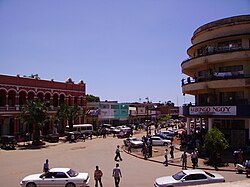| Current name | Former name in French | Former name in Dutch | Former namesake |
|---|
| Aketi | Aketi Port-Chaltin | Aketi-Chaltinhaven | Named in honour of Louis-Napoléon Chaltin, a colonial military officer of the Congo Free State |
| Andoma | Liénartville | Lienartstad | Named in honour of Charles-Victor Liénart, explorer and colonial military officer |
| Banalia | Sainte Élisabeth | Sint Elisabeth | Named after Elizabeth, mother of John the Baptist |
| Bandundu | Banningville | Banningstad | Named in honour of Émile Banning, influential Belgian civil servant and confidant of Leopold II |
| Bariki | Joseph | |
| Boteka | Flandria | Flanders, a region in Belgium |
| Bukavu | Costermansville | Costermansstad | Named in honour of Paul Costermans, colonial administrator in the Free State, in 1927 |
| Bunkonde | Hemptinne-Saint-Benoît | Named in honour of Jean-Félix Hemptinne, a Belgian monk and the Order of Saint Benedict |
| Djokupunda | Charlesville | Charlesstad | |
| Ebabaka | Tursz | |
| Ebonda | Alberta | Named in honour of King Albert I |
| Epulu | Camp Putnam [a] | Named after Patrick Tracy Lowell Putnam, American anthropologist |
| Gombe (Kinshasa) | Kalina | Named in honour of E. Kalina, an Austrian soldier who died in 1883 |
| Ilebo | Port-Francqui | Francquihaven | Named in honour of Émile Francqui, businessman and philanthropist |
| Isiro | Paulis | Named in honour of Albert Paulis |
| Kalemie | Albertville | Albertstad | Named in honour of King Albert I |
| Kananga | Luluabourg | Luluaburg | Named after the nearby Lulua river |
| Kanzenze | Liège Sacré-Cœur | Named after the Belgian city Liège and the Sacred Heart |
| Kasa-Vubu (Kinshasa) | Dendale | |
| Kasese | Ferme Cobelkat | |
| Kasongo | Saint-Charles | |
| Katana | Liège Saint-Lambert | Named after the Belgian city Liège and St Lambert of Maastricht |
| Katofio | Auberge | |
| Katubu | Salèssiene | Named after the Salesian Order |
| Kikwit | Poto-Poto [b] | |
| Kindamba | Bailleux | Named in honour of Hector Bailleux, Belgian businessman |
| Kindu | Kindu Port-Émpain | Kindu Empain-Haven | Named in honour of Edouard Empain, Belgian industrialist |
| Kinshasa | Léopoldville | Leopoldstad | Named in honour of King Leopold II, King-Sovereign of the Congo Free State |
| Kirungu | Baudouinville | Boudewijnstad | Named in honour of Prince Baudouin, nephew (and intended successor) of Leopold II |
| Kisala-Mbati | Salamadie | |
| Kisangani | Stanleyville | Stanleystad | Named in honour of Henry Morton Stanley, explorer |
| Kwilu Ngongo | Moerbeke | Named after the Belgian hometown of Maurice Lippens, a major investor in the local sugar industry |
| Likasi | Jadotville | Jadotstad | Named in honour of Jean Jadot [ fr ], businessman and industrialist |
| Lingwala (Kinshasa) | Saint-Jean | Named after St John the Apostle |
| Lubao | Sentery | |
| Lubumbashi | Élisabethville | Elisabethstad | Named in honour of Queen Elisabeth |
| Lufu-Toto | Cattier | Named in honour of Félicien Cattier, businessman |
| Luila | Wolter | |
| Lukutola Kivumo | Ferme Servranckx | |
| Lusaka | Lusaka Saint-Jacques | Named after St. James the Great |
| Lokandu | Riba-Riba | |
| Lokutu | Elisabetha | Named in honour of Queen Elisabeth |
| Lusanga | Leverville | Leverstad | Named after William Lever, British businessman and co-founder of Lever Brothers which owned a local subsidiary, Huileries du Congo Belge (HCB), which produced palm kernels |
| Makanza | Nouvelle-Anvers | Nieuw Antwerpen | Named after the Belgian port city of Antwerp |
| Makiso | Stanley | Named in honour of Henry Morton Stanley, explorer and namesake of Stanleyville |
| Manzonzi | Cipelo | |
| Mapangu | Brabanta | Named after Brabant in Belgium |
| Matonge (Kinshasa) | Renkin | Named in honour of Jules Renkin, Belgian politician, Colonial Minister (1908–18) and later Prime Minister (1931–32) |
| Mbandaka | Coquilhatville [c] | Cocquilhatstad | Named in honour of Camille Coquilhat, colonial administrator and town's founder |
| Mbanza-Ngungu | Thysville | Thysstad | Named in honour of Albert Thys, Belgian colonist and businessman |
| Mobayi-Mbongo | Banzyville | Banzystad | |
| Mbuji-Mayi | Bakwanga | |
| Mombelaya | Saint-Trudon | Named after St. Trudo |
| Muluila | Greinerville | Greinerstad | |
| Mweke | Dethieu | |
| Ngaliema (Kinshasa) | Stanley | Named in honour of Henry Morton Stanley, explorer |
| Nkaw | Saint-Camille | Named after St. Camillus de Lellis |
| Nsiamfumu | Vista | |
| Nzoro | Vankerckhovenville | Vankerckhovenstad | Named in honour of Belgian explorer Willem Frans Van Kerckhoven |
| Sola | Bruges Saint-Donat | | Named after the Belgian city Bruges and St. Donatus of Muenstereifel |
| Tongelo | Tongerlo-Saint-Norbert | Named after the Belgian town Tongerlo and St Norbert of Xanten |
| Tshilundu | Mérode-Salvador | Named after the House of Mérode |
| Ubundu | Ponthierville | Ponthierstad | Named in honour of Pierre Ponthier [ fr ], colonial soldier |





